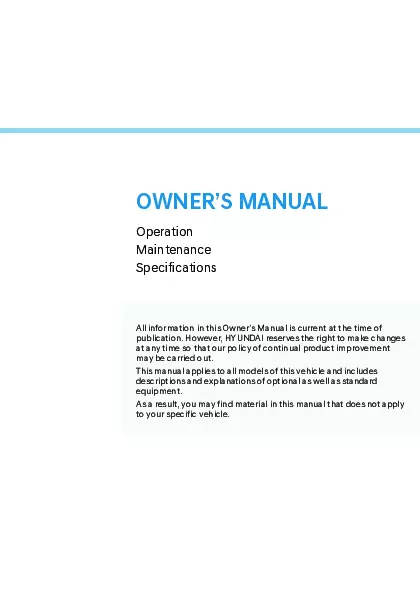2026 Hyundai Ioniq 9 Owner's Manual

Table of Contents
2026 Hyundai Ioniq 9 Overview
Owner's Manual
The Owner's Manual for the 2026 Hyundai Ioniq 9 serves as an indispensable guide to understanding your vehicle's features, functionality, and maintenance needs. It provides comprehensive instructions on operating the car safely and efficiently, ensuring you can make the most of your driving experience. Within its pages, you’ll find valuable information on routine checks, troubleshooting tips, and vehicle care schedules, allowing you to maintain the Ioniq 9 in peak condition. Furthermore, the manual includes vital safety information, warranty details, and technical specifications, making it a key resource for addressing any questions or concerns that may arise during ownership. Trusting your Ioniq 9 to operate at its best starts with knowledge—your manual is your first step toward that understanding.
Introduction
The 2026 Hyundai Ioniq 9 is an exhilarating leap forward in the realm of electric vehicles, combining contemporary style with cutting-edge technology. Designed with sustainability in mind, this all-electric SUV redefines modern driving through its impressive efficiency and innovative features. With an unmistakable aesthetic, the Ioniq 9's aerodynamic silhouette and striking LED lighting fuse function with beauty, ensuring it turns heads on every road. This model encapsulates Hyundai's dedication to producing eco-friendly vehicles without sacrificing comfort or performance, making the Ioniq 9 an exceptional choice for forward-thinking drivers.
Powertrains
Under the hood, the 2026 Hyundai Ioniq 9 offers a range of potent and efficient electric powertrains designed to deliver impressive acceleration and range. Powered by advanced lithium-ion battery technology, the model boasts an all-electric driving range that comfortably exceeds its competitors. Featuring a dual-motor setup in higher trims, the Ioniq 9 accelerates with remarkable speed while maintaining efficiency. With an impressive fast-charging capability, drivers can spend less time plugged in and more time enjoying the journey.
Trims
The Ioniq 9 presents various trim levels tailored to cater to diverse consumer preferences and budgets. Entry-level trims come generously equipped with essential safety and technology features, while higher trims introduce luxury upgrades such as premium audio systems, advanced driver-assistance technologies, and enhanced interior materials. Each trim level builds upon the last, allowing owners to select the perfect configuration that suits their individual needs and lifestyle.
Features
The 2026 Hyundai Ioniq 9 is outfitted with a plethora of innovative features aimed at enhancing both comfort and safety. Standard amenities include a state-of-the-art infotainment system equipped with a large touchscreen display, smartphone integration, and voice recognition. Safety features such as adaptive cruise control, lane-keeping assist, and a 360-degree camera system ensure peace of mind on the road. Additionally, eco-friendly elements like recyclable materials in the interior design reflect Hyundai's commitment to sustainability. The Ioniq 9 brilliantly combines technology, luxury, and responsibility, creating an unparalleled driving experience.
User manual download
The Hyundai Ioniq 9 owner manual for the 2026 model year is to be found in PDF downloadable format on this page. The owner manual for the model year 2026 is free and in English, but the repair manuals are usually not easy to get and may cost more.
Manual Questions
Fill the form below and someone will help you!
